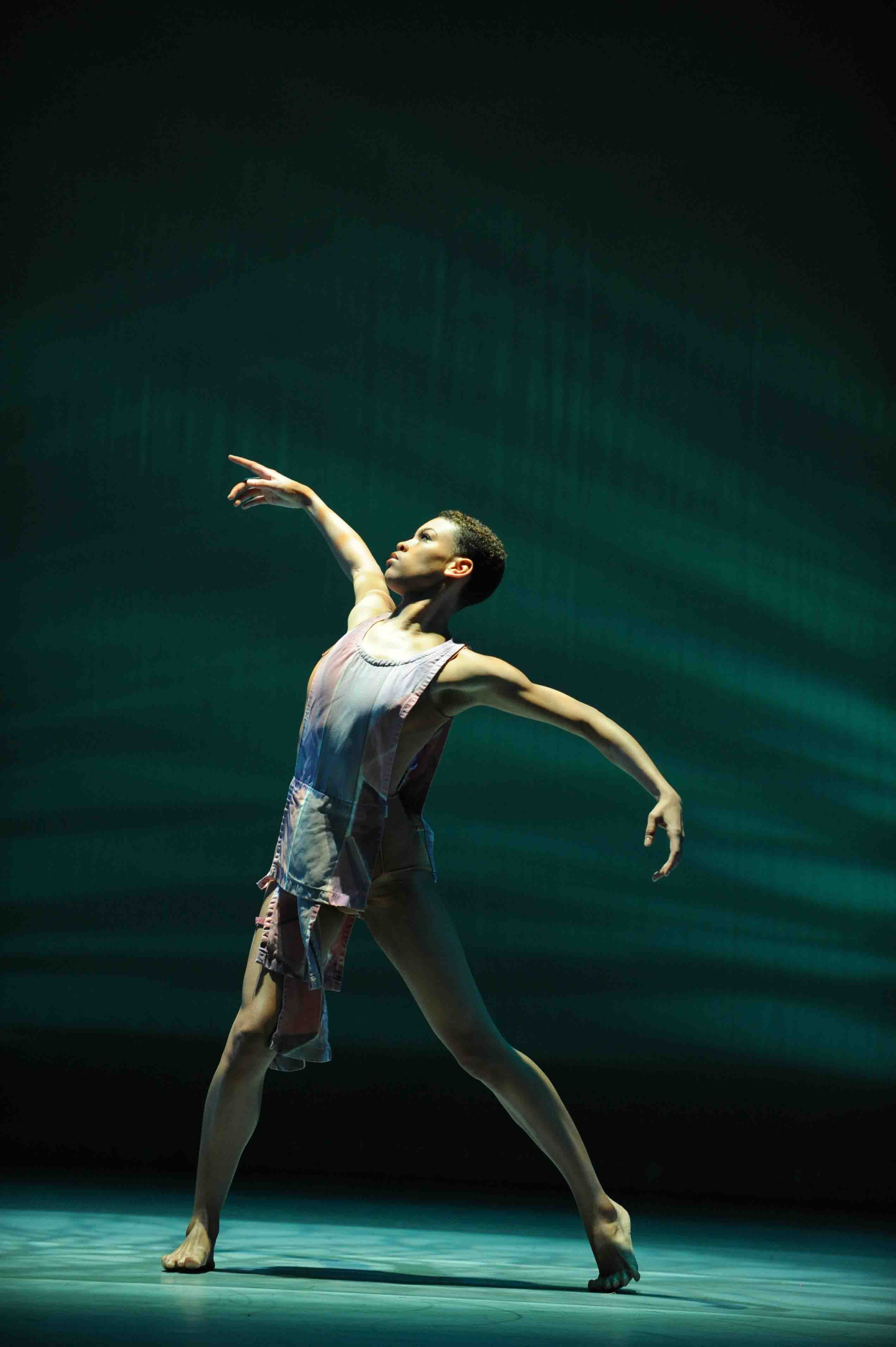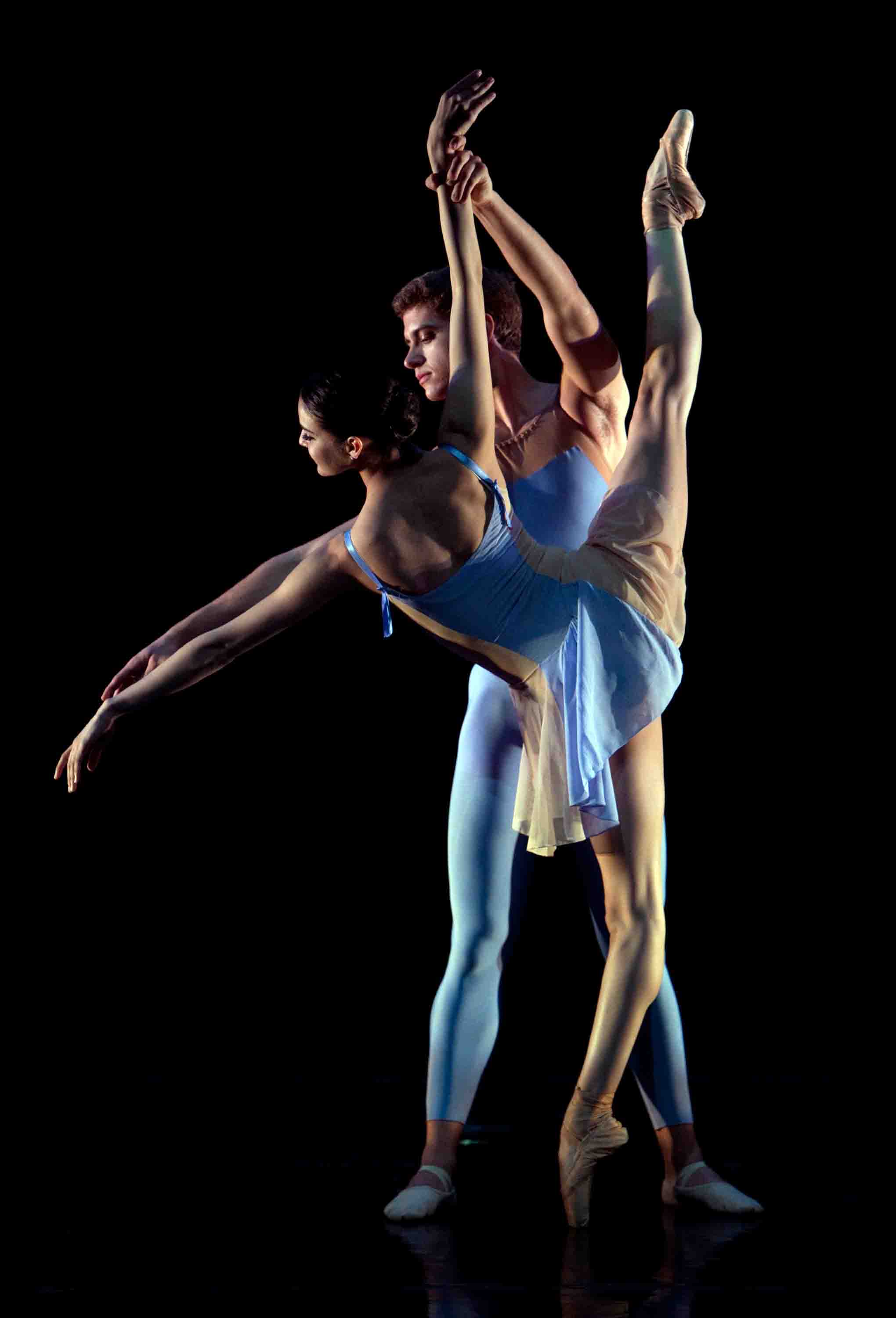1.2.3 Festival / Joyce Theater, NYC / April 13 – 25, 2010

Ailey II’s Ghrai DeVore in Judith Jamison’s
Divining
Photo: Eduardo Patino
Opening night of the 1.2.3 Festival at the Joyce was the tasting menu. The three (count ’em) companies involved in this yearly event–ABT II, AILEY II, and Taylor 2–contributed one substantial, and revealing, dance to the program. Each little troupe is an offshoot of a top-notch, grand-scale company: American Ballet Theatre, Alvin Ailey American Dance Theater, and the Paul Taylor Dance Company. The junior groups serve as ambassadors of dance, touring to venues that lack the space, budget, and sizable audience needed to host the grander companies, all the while increasing their professional aplomb. The young members of the second companies are, for the most part, on their way to the big time, and the evening at the Joyce displayed both the style that distinguishes the parent company of each and the dancers’ individual gifts.
Taylor 2 opened the program and won the day with its rendition of Company B, engagingly set to bubbly or yearning songs popular in the Forties, sung by the Andrews Sisters. Taylor’s choreography shadows the moods of the music with images of World War II, in which many a lighthearted boyfriend or cut-up suddenly found himself an armed soldier facing the enemy and, often, death.
In this way, “There Will Never Be Another You” becomes not just an ex-sweetheart’s lament over a romance that has gone awry, from which both parties are likely to recover eventually, but rather for a romance cut off in one fell swoop by a visit to the young man’s parents from a pair of somber emissaries of the United States Armed Forces.
Similarly, Taylor gives an extra dimension to the lyrics of “I Can Dream, Can’t I?” by having a young woman’s wistful query about the unresponsive object of her affections answered by images in silhouette of two fellows who only have eyes for each other. Elsewhere, in “Pennsylvania Polka” and “Oh Johnny, Oh Johnny, Oh!,” the impulse is chiefly one of ebullient cavorting, something, it seems nowadays, that America will never retrieve.
The Taylor 2 dancers embodied the unfettered feelings of youth required for Company B, yet their skills and assurance are utterly professional. The combination is irresistible. Two of the three men in the company are, understandably, throwbacks to the beefy types Taylor often commandeers for his main company; this may be part of the “blast at ballet” that choreographers of his generation needed to make as they carved their own, idiosyncratic, path.
As a group, the guys are irrepressible; the sun seems to shine on their innocent rowdiness. The three women are very individual and capable, bless them, of conveying mood and emotion through dancing rather than add-on histrionics. Latra Wilson was my favorite–juicy and teasing in “Rum and Coca-Cola” as a Trinidad native exhibiting her charms to a trio of American soldiers who lie lazily on the ground, ogling the object of their generic desires. She is, deliciously, “working for the Yankee dollar,” and she’s worth a million.
ABT II’s contribution to the program was the evening’s weakest entry, but this was not primarily the dancers’ fault. The choreography of Edwaard Liang’s Ballo per Sei defeats them, being both physically illogical (hardly a step in it segues into a move that the body would instinctively do next) and unmusical (an untenable response to its Vivaldi score). What’s more (or, rather, less), for long stretches the piece is intolerably boring. ABT II has, for some time now, prided itself on commissioning new works to be made on its dancers, who would then be part of the “creative” endeavor, as if dancing itself were not creative. I’ve felt all along that an emphasis on performing the classics might serve them better.
Still, Liang’s choreography wasn’t entirely to blame for the not-so-hot performance of the dancers. The current company members are nowhere near such able practitioners of their trade as, for instance, the members of Taylor 2. Comparing them, more aptly, to a classical group, their technique lacks the sharp edge and brilliant footwork on view at the annual performances given by the School of American Ballet, which grooms dancers for the New York City Ballet.

ABT II’s Brittany DeGrofft and Brian Waldrep in Edwaard Liang’s Ballo per Sei
Photo: Rosalie O’Connor
The young women of ABT II are more capable technically than the men who, moreover, do not always make reliable partners. And yet all the performers gave the audience glimpses of talent that just needs time and guidance to mature. The one passage of fully fledged dancing came from Brittany DeGrofft in the long adagio duet at the heart of Liang’s piece. DeGrofft had evidently convinced herself that her role was expressive, and expressive she was in her rendition. Her performance wasn’t profound–she’s probably too young in experience for that–but she obviously knew what it should be like. In time, with better material, she may be wonderful.
The denizens of Judith Jamison’s Divining, presented by Ailey II, seem to be an ancient nomadic tribe given to mystical rituals. A small group of them that opens the piece and an expanded one that appears at the end move together, suggesting a powerful collective consciousness. For the all-important middle section of the dance, these strong-bodied, strong-minded people conjure up a female goddess–to protect them and lead them, it would seem; perhaps to inspire them. Danced by the remarkable Ghrai DeVore, this central figure is one you’re not likely to forget.
DeVore rivets your eyes the moment she sets a foot, delicate but sure, on the stage. Just physically, she’s stunning. Her arms have the fragile beauty of a slender pre-adolescent child’s; her thighs are those of a mature athletic woman, full and vigorous. Her head, exquisitely shaped, is perfectly poised; her neck might be its pedestal. Large eyes, emphasized by ebony makeup. A luscious mouth. The cut of her black hair must have been designed by a sculptor: close-cropped but thick from crown to earlobes, then shaved away below. Granted, beauty is as beauty does, but here it does fantastically.
In action, DeVore is vehemently expressive, yet subtle in detail. She can shift, with no visible transitions, from tiny vibrations to steady extended balances, from staccato thrusts to soaring leaps. At one point she jackknifes over, one palm slapping the floor, while the opposite leg reaches straight skyward, the foot seeming to pierce the atmosphere like a fatal arrow. For DeVore, an action like this is not a feat; it’s business as usual. No, she’s not on her way to stardom. She is already a star.
Subsequent performances in the 123 Festival will be devoted to full programs by a single one of the three participating companies. Taylor 2 is offering the most captivating show–Aureole, 3 Epitaphs, Company B, and Esplanade–four masterworks by the choreographer in which joy or fun has the upper hand, not one of them suggesting, as a good part of Taylor’s complete repertory does, that life is nothing but an amalgam of evil, madness, violence, and despair. (Think of Last Look). What better way to lure prospective fans than the combination of excellence and pleasure?
© 2010 Tobi Tobias




As TT sensitively chronicles, there was remarkable dancing from each company. I was especially taken with certain details of Taylor 2’s “Company B,” details for the women, which I don’t recall from the parent company’s production. The Taylor 2 dancers, by the way, were rehearsed by Patrick Corbin, the memorable “Johnny Oh!” of this dance.
Thank you.
Very nice post.